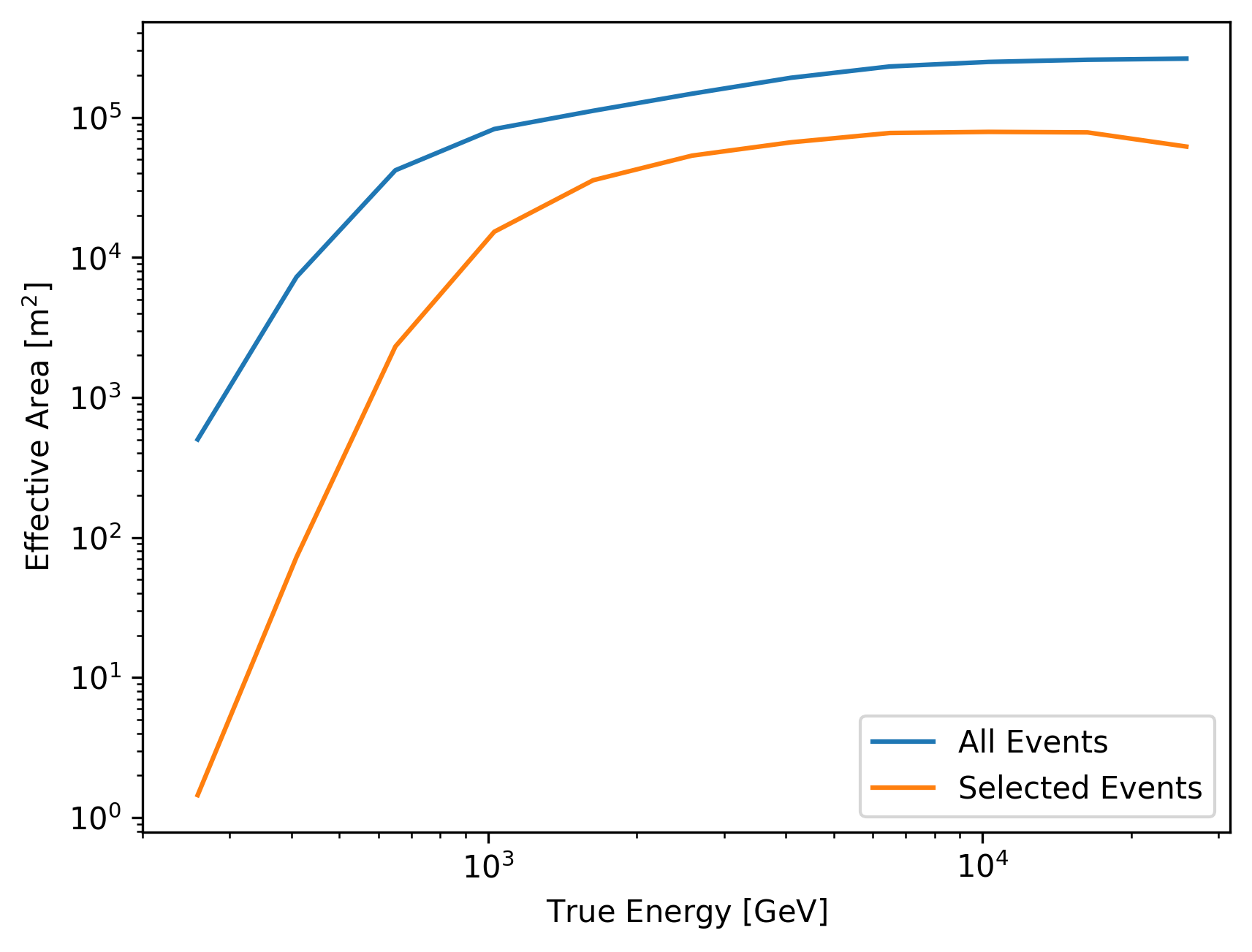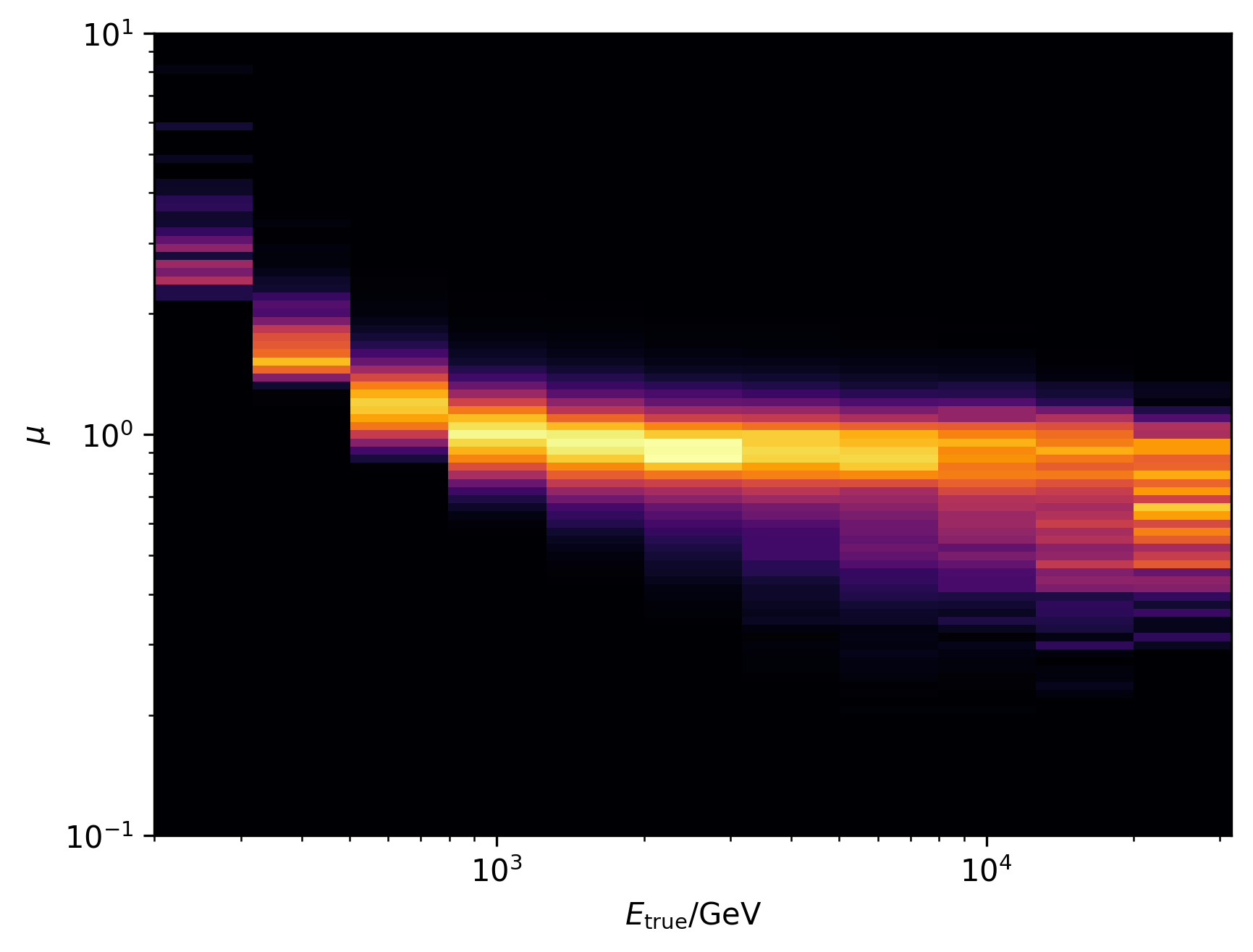Using pyirf to calculate IRFs from the FACT Open Data
Note In FACT, we used a different terminology, partly because of being a monoscopic telescope or out of confusion witht the CTA terms, in this context DL3 are reconstructed events, but not necessarily already with the IRF
[1]:
import numpy as np
import astropy.units as u
import matplotlib.pyplot as plt
import subprocess as sp
[2]:
%matplotlib inline
Download Data
[3]:
path = "gamma_test_dl3.hdf5"
url = f"https://factdata.app.tu-dortmund.de/dl3/FACT-Tools/v1.1.2/{path}"
ret = sp.run(["curl", "-z", path, "-fsSLO", url], stdout=sp.PIPE, stderr=sp.PIPE, encoding='utf-8')
if ret.returncode != 0:
raise IOError(ret.stderr)
Read in the data
[4]:
from astropy.table import QTable
import astropy.units as u
import tables
Simulated Event Info
Currently, pyirf only works with powerlaw simulated events, like CORSIKA does it. We want to also support arbitrary histograms / event distributions, but that is not yet implemented.
This can be created from a file with that information, but I will just create it here.
[5]:
from pyirf.simulations import SimulatedEventsInfo
simulation_info = SimulatedEventsInfo(
energy_min=200 * u.GeV,
energy_max=50 * u.TeV,
spectral_index=-2.7,
n_showers=12600000,
max_impact=300 * u.m,
viewcone_min=0 * u.deg,
viewcone_max=0 * u.deg,
)
DL2 Event List
pyirf does not prescribe or use a specific DL2 file format. You need to read the data into an astropy.table.QTable following our conventions, detailed in the docs here:
https://cta-observatory.github.io/pyirf/introduction.html#dl2-event-lists
[6]:
gammas = QTable()
# mapping of <target column name>: (<column in the file, unit>)
columns = {
'obs_id': ('run_id', None),
'event_id': ('event_num', None),
'reco_energy': ('gamma_energy_prediction', u.GeV),
'true_energy': ('corsika_event_header_total_energy', u.GeV),
'true_az': ('source_position_az', u.deg),
'pointing_az': ('pointing_position_az', u.deg),
'theta': ('theta_deg', u.deg),
'gh_score': ('gamma_prediction', None),
}
with tables.open_file('gamma_test_dl3.hdf5', mode='r') as f:
events = f.root.events
for col, (name, unit) in columns.items():
if unit is not None:
gammas[col] = u.Quantity(events[name][:], unit, copy=False)
else:
gammas[col] = events[name][:]
gammas['true_alt'] = u.Quantity(90 - events['source_position_zd'][:], u.deg, copy=False)
gammas['pointing_alt'] = u.Quantity(90 - events['pointing_position_zd'][:], u.deg, copy=False)
# make it display nice
for col in gammas.colnames:
if gammas[col].dtype == float:
gammas[col].info.format = '.2f'
[7]:
gammas[:10]
[7]:
| obs_id | event_id | reco_energy | true_energy | true_az | pointing_az | theta | gh_score | true_alt | pointing_alt |
|---|---|---|---|---|---|---|---|---|---|
| GeV | GeV | deg | deg | deg | deg | deg | |||
| int64 | int64 | float64 | float64 | float64 | float64 | float64 | float64 | float64 | float64 |
| 11583 | 403 | 638.00 | 712.87 | 353.00 | 349.76 | 1.49 | 0.45 | 79.34 | 79.33 |
| 106806 | 237 | 815.28 | 885.04 | 353.00 | 42.35 | 0.02 | 0.82 | 89.37 | 89.23 |
| 11325 | 166 | 838.62 | 928.05 | 353.00 | -4.95 | 0.26 | 0.75 | 83.37 | 83.92 |
| 13486 | 165 | 680.72 | 420.22 | 353.00 | 348.77 | 0.13 | 0.78 | 81.92 | 82.02 |
| 14228 | 122 | 1896.68 | 2458.86 | 353.00 | 351.27 | 0.08 | 0.88 | 70.51 | 70.69 |
| 108312 | 221 | 4430.69 | 5347.98 | 353.00 | -5.94 | 0.05 | 0.97 | 66.55 | 66.12 |
| 13327 | 310 | 3649.23 | 4550.83 | 353.00 | 347.98 | 0.04 | 0.91 | 83.53 | 83.75 |
| 107296 | 237 | 1723.47 | 2109.52 | 353.00 | 350.67 | 0.05 | 0.20 | 82.56 | 82.05 |
| 14269 | 217 | 956.90 | 953.94 | 353.00 | -5.98 | 0.17 | 0.79 | 69.53 | 70.02 |
| 108669 | 183 | 804.27 | 626.66 | 353.00 | -6.38 | 0.12 | 0.84 | 61.06 | 60.54 |
Apply Event Selection
We remove likely hadronic events by requiring a minimal gh_score.
We will calculate point-like IRFs, that means selecting events in a radius around the assumed source position.
[8]:
gammas['selected_gh'] = gammas['gh_score'] > 0.8
gammas['selected_theta'] = gammas['theta'] < 0.16 * u.deg
gammas['selected'] = gammas['selected_gh'] & gammas['selected_theta']
np.count_nonzero(gammas['selected']) / len(gammas)
[8]:
0.18115575805640652
Calculate IRFs
Effective area
We only have point-like simulations at a specific wobble offset (0.6° for FACT), so we calculate the effective area for all events at once, equivalent to a single fov offset bin.
Create the binning
[9]:
from pyirf.binning import create_bins_per_decade, bin_center
[10]:
true_energy_bins = create_bins_per_decade(simulation_info.energy_min, simulation_info.energy_max, 5)
# single offset bin around the wobble distance
# since we are dealing with point-like simulations
wobble_offset = 0.6 * u.deg
fov_offset_bins = [0.59, 0.61] * u.deg
Calculate effective area
Effective area is calculated before and after cuts, for the IRF, we only need after the event selection has been applied.
The difference between point-like IRFs and Full-Enclosure IRFs is if a theta cut has been applied or not.
[11]:
from pyirf.irf import effective_area_per_energy
aeff_all = effective_area_per_energy(gammas, simulation_info, true_energy_bins)
aeff_selected = effective_area_per_energy(gammas[gammas['selected']], simulation_info, true_energy_bins)
Let’s use gammapy to plot the IRF
[12]:
# utility function to converet pyirf Quantities to the gammapy classes
from pyirf.gammapy import create_effective_area_table_2d
plt.figure()
for aeff, label in zip((aeff_all, aeff_selected), ('All Events', 'Selected Events')):
aeff_gammapy = create_effective_area_table_2d(
# add a new dimension for the single fov offset bin
effective_area=aeff[..., np.newaxis],
true_energy_bins=true_energy_bins,
fov_offset_bins=fov_offset_bins,
)
aeff_gammapy.plot_energy_dependence(label=label, offset=[wobble_offset])
plt.xlim(true_energy_bins.min().to_value(u.GeV), true_energy_bins.max().to_value(u.GeV))
plt.yscale('log')
plt.xscale('log')
plt.legend()
print(aeff_gammapy)
/home/docs/checkouts/readthedocs.org/user_builds/pyirf/envs/latest/lib/python3.9/site-packages/tqdm/auto.py:21: TqdmWarning: IProgress not found. Please update jupyter and ipywidgets. See https://ipywidgets.readthedocs.io/en/stable/user_install.html
from .autonotebook import tqdm as notebook_tqdm
EffectiveAreaTable2D
--------------------
axes : ['energy_true', 'offset']
shape : (11, 1)
ndim : 2
unit : m2
dtype : float64

Point Spread Function
The point spread function describes how well the direction of the gamma rays is estimated.
[13]:
from pyirf.irf import psf_table
from pyirf.utils import calculate_source_fov_offset
gammas['true_source_fov_offset'] = calculate_source_fov_offset(gammas)
source_offset_bins = np.linspace(0, 3, 100) * u.deg
# calculate this only for the events after the gamma/hadron separation
psf = psf_table(gammas[gammas['selected_gh']], true_energy_bins, source_offset_bins, fov_offset_bins)
[14]:
psf.shape
[14]:
(11, 1, 99)
Again, let’s use gammapy to plot:
[15]:
from pyirf.gammapy import create_psf_3d
psf_gammapy = create_psf_3d(psf, true_energy_bins, source_offset_bins, fov_offset_bins)
plt.figure()
psf_gammapy.plot_psf_vs_rad(offset=[wobble_offset], energy_true=[1., 10.]*u.TeV)
plt.legend(plt.gca().lines, ['1 TeV', '10 TeV'])
[15]:
<matplotlib.legend.Legend at 0x7fde95d07040>

Energy Dispersion
Describes how well the energy is estimated
[16]:
from pyirf.irf import energy_dispersion
# logarithmic space, is "symmetric" in terms of ratios 0.1 is a factor of 10 from 1 is a factor of 10 from 10
migration_bins = np.geomspace(0.1, 10, 100)
edisp = energy_dispersion(
gammas[gammas['selected']],
true_energy_bins=true_energy_bins,
fov_offset_bins=fov_offset_bins,
migration_bins=migration_bins,
)
Plot edisp
[17]:
from gammapy.irf import EnergyDispersion2D
plt.figure()
plt.pcolormesh(
true_energy_bins.to_value(u.GeV),
migration_bins,
edisp[:, :, 0].T,
cmap='inferno'
)
plt.xlabel('$E_\mathrm{true} / \mathrm{GeV}$')
plt.ylabel('$\mu$')
plt.yscale('log')
plt.xscale('log')

Export to GADF FITS files
We use the classes and methods from astropy.io.fits and pyirf.io.gadf to write files following the GADF specification, which can be found here:
https://gamma-astro-data-formats.readthedocs.io/en/latest/
[18]:
from pyirf.io.gadf import create_aeff2d_hdu, create_energy_dispersion_hdu, create_psf_table_hdu
from astropy.io import fits
from astropy.time import Time
from pyirf import __version__
# set some common meta data for all hdus
meta = dict(
CREATOR='pyirf-v' + __version__,
TELESCOP='FACT',
INSTRUME='FACT',
DATE=Time.now().iso,
)
hdus = []
# every fits file has to have an Image HDU as first HDU.
# GADF only uses Binary Table HDUs, so we need to add an empty HDU in front
hdus.append(fits.PrimaryHDU(header=fits.Header(meta)))
hdus.append(create_aeff2d_hdu(aeff_selected, true_energy_bins, fov_offset_bins, **meta))
hdus.append(create_energy_dispersion_hdu(edisp, true_energy_bins, migration_bins, fov_offset_bins, **meta))
hdus.append(create_psf_table_hdu(psf, true_energy_bins, source_offset_bins, fov_offset_bins, **meta))
fits.HDUList(hdus).writeto('fact_irf.fits.gz', overwrite=True)